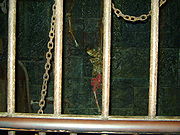
Prison cell
Encyclopedia

Prison
A prison is a place in which people are physically confined and, usually, deprived of a range of personal freedoms. Imprisonment or incarceration is a legal penalty that may be imposed by the state for the commission of a crime...
, or police station
Police station
A police station or station house is a building which serves to accommodate police officers and other members of staff. These buildings often contain offices and accommodation for personnel and vehicles, along with locker rooms, temporary holding cells and interview/interrogation rooms.- Facilities...
where a prisoner
Prisoner
A prisoner is someone incarcerated in a prison, jail or similar facility.Prisoner or The Prisoner may also refer to:* Prisoner of war, a soldier in wartime, held as by an enemy* Political prisoner, someone held in prison for their ideology...
is held.
Prison cells are usually about 6 by 8 feet in size with steel or brick walls and one solid or barred door that locks from the outside. Many modern prison cells are pre-cast. Solid doors may have a window that allows the prisoner to be observed from the outside. Furnishings and fixtures inside the cell are constructed so that they cannot be easily broken and are anchored to the walls or floor. Stainless steel lavatories and commodes are also used. This prevents vandalism or the making of weapons.
There are a number of prison and prison cell configurations, from simple police station holding cells to massive cell blocks in larger correctional facilities.
In the United Kingdom
United Kingdom
The United Kingdom of Great Britain and Northern IrelandIn the United Kingdom and Dependencies, other languages have been officially recognised as legitimate autochthonous languages under the European Charter for Regional or Minority Languages...
, cells in a police station
Police station
A police station or station house is a building which serves to accommodate police officers and other members of staff. These buildings often contain offices and accommodation for personnel and vehicles, along with locker rooms, temporary holding cells and interview/interrogation rooms.- Facilities...
are the responsibility of the Custody Sergeant
Sergeant
Sergeant is a rank used in some form by most militaries, police forces, and other uniformed organizations around the world. Its origins are the Latin serviens, "one who serves", through the French term Sergent....
, who also logs each detainee and allocates him or her an available cell. Custody Sergeants also ensure cells are clean and as germ-free as possible, in accordance with the Human Rights Act
Human Rights Act
A human rights act is a statute that sets out individual rights and freedoms under the law. Many jurisdictions have bills of rights enshrined into law and called the "Human Rights Act". This naming convention is commonly used in Commonwealth nations...
.
The practice of assigning only one inmate to each cell in a prison is called single-celling
Single-celling
Single-celling is the practice of assigning only one inmate to each cell in a prison. John Howard has been credited as establishing the practice of single-celling in the United Kingdom and, by extension, in the United States...
.

